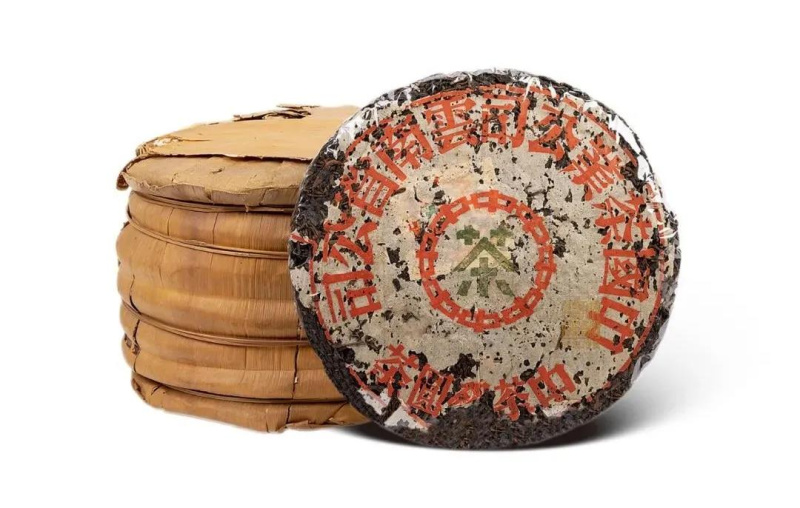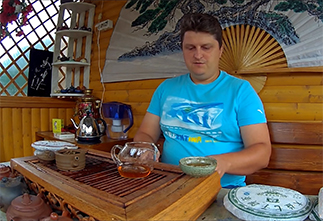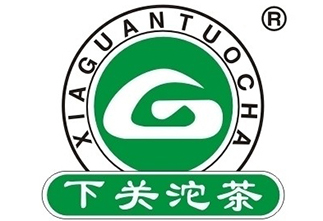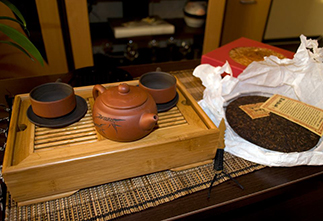When warmed up with your breath, you can catch a dry, very subtle aroma with light leather notes and shades of old aged herbs, stored for a long time in the attic. After washing, the shades intensify, reminiscent of that unique smell when you hold in your hands an old leather briefcase with school notebooks inside.
The taste of brewed tea is subtle, with soft bitterness, balanced and playful. The taste has pleasant shades of old leather, roasted almonds, and touches of aged whiskey. Starting from the 3rd infusion, the infusion acquires sweetish nuances with a bright nutty dominant.
This puer can be brewed 6 times, it changes from infusion to infusion, preserving its aroma for a long time in an empty cup. To fully reveal the taste of puer, you need to use a teapot made of Yixing clay. To prepare the infusion, you will need 5-7 g per 150-200 ml of water.
The color of the finished infusion is chocolate-brown, with a pleasant cognac shade, clean and transparent. During tea drinking, a rich, moderately tart aftertaste with heady woody-almond shades is felt.
The effect of Cha Qi (tea energy) is noticeable after the first cup. Tea gives a meditative state, warms the body well, strongly tones, stimulates mental activity and encourages action. Makes the eyes sharp, movements clear, lifts the mood and creates a feeling of comfort.
Shu puer 2007 "Lux" brand "Pine and Crane" factory "Xiaguan" - aged tea with a unique taste and strong tea effect. It can be used for thoughtful, ceremonial tea drinking alone, or will be an excellent gift for lovers of aged puer.
|
Name in Chinese
|
特级 |
|
Pinyin
|
tèjí |
|
Translation
|
Lux |
|
Country
|
China |
|
District
|
Dali-Bay Autonomous Region |
|
Provinces
|
Yunnan (云南) |
|
Region
|
Dali Bai Autonomous Prefecture (大理白族自治州) |
|
Manufacturer
|
Сягуань (云南下关沱茶集团) |
|
Raw material production date
|
2007 |
|
Year of pressing
|
2007 |
|
Pressing form
|
Tuo Cha (Tuo Tea) |
|
Declared weight, g
|
100 |
|
Tea tree (bush) variety
|
Gu Shu |
|
Size
|
10x10x5 |
|
Length, cm
|
10 |
|
Width, cm
|
10 |
- Комментарии
- Вконтакте
Pu-erh is one of the most unique types of tea, which only gets better with age. Many people, when they first encounter this tea, wondered: why is pu-erh more often found in pressed form (cakes, bricks, tochas), and not in loose form? The reasons for this are related to both history and the practical aspects of storing and fermenting tea. Despite modern technologies that allow the production of loose pu-erh, the shape of pressed cakes remains unchanged. And pu-erh is more often found on sale in pressed form, for example, in the form of cakes or bricks, and loose pu-erh is less common. We will talk about the reasons for pressing pu-erh into cakes in this article.
Puer is a unique Chinese tea that is distinguished by its depth of taste, complexity of aromas and versatility of aftertaste. Its taste characteristics are formed under the influence of many factors, from growing conditions to the brewing method. Let's look at the main ones.
Сягуаньский чайный завод имеет более чем 70-ти летнюю историю. Он был основан в 1941 году и находится в г. Дали, провинция Юньнань, который часто называют восточной Швейцарией. Прекрасная природа и благоприятная погода, горы и чистейшие озера дают возможность производить пуэр великолепного качества. Сягуаньский чайный завод является одним из главных производителей прессованного чая в Китае. Он производит более 6000 тон чая пуэр ежегодно. Сягуаньский завод производит как Шу пуэр, так и Шен пуэр. Однако наибольшую популярность и признание заслужили Шен пуэры точа (в форме гнезда, чаши) и бинча (в форме блина).
The question often arises: how to brew puerh correctly? Sometimes the phrase "to get high" is added to it. Moreover, everyone has their own understanding of this phrase. Some mean vigor, and some - intoxication. So how to brew puerh tea correctly? Let's consider several options.
Traveling through the tea mountains, we found ourselves in another land of blue roofs - the village of Zhongcai, which is located in the Menghai district of Yunnan province. According to tradition, we were shown another local tea tree, which, according to the Chinese, is at least a million years old :) The village is very authentic, not designed for tourists, there are many wild pu-erhs there and, of course, we were warmly received. They treated us to local cuisine and tea. We also asked the residents about the prices of tea and how they have changed in recent years.
The tea ceremony occupies a special place in the centuries-old Eastern tradition. And although the essence of this phenomenon remains constant, the nature and external manifestations of the tea ceremony in different nations have their own national characteristics. In each Chinese province, the tea ceremony and the tea used in it are varied: for example, residents of the southern provinces prefer green tea, and residents of the northern provinces - red tea, in Fujian province they more often use Oolong tea, and in Yunnan province Puer tea is widely known.



























































































